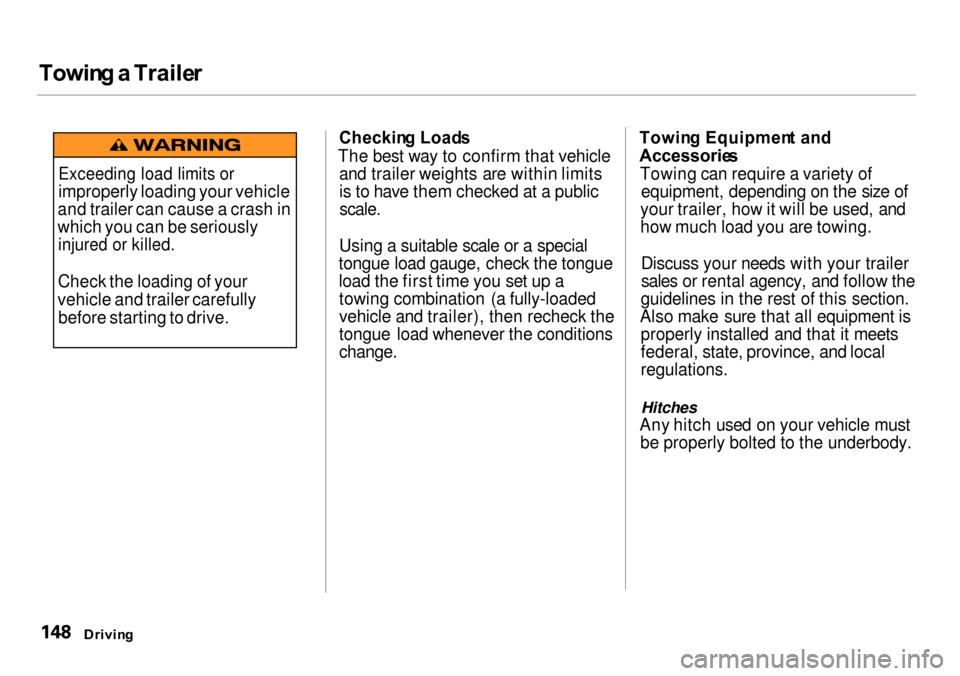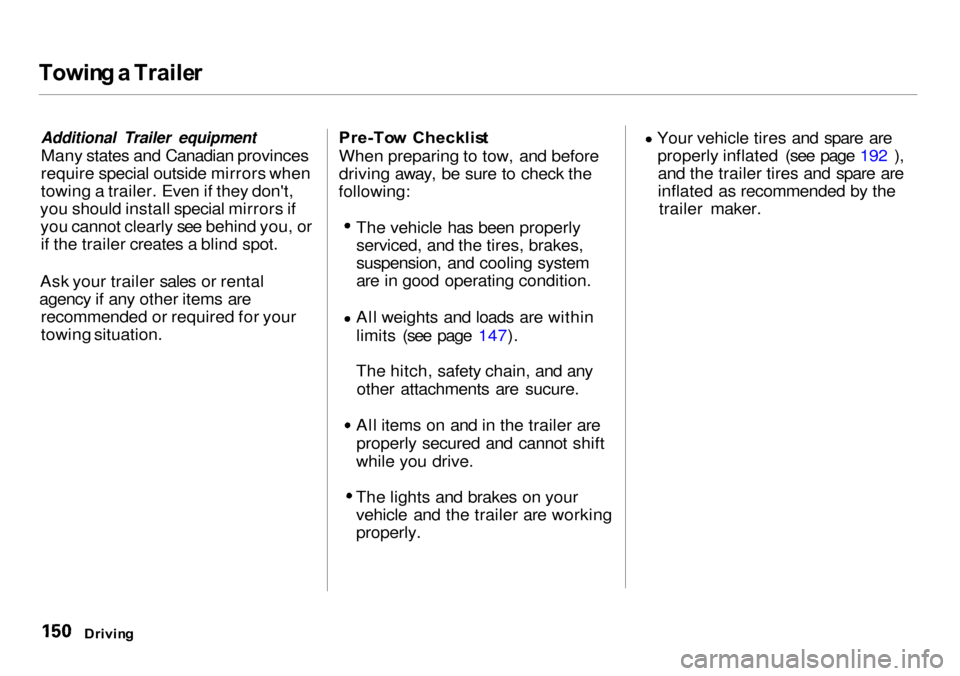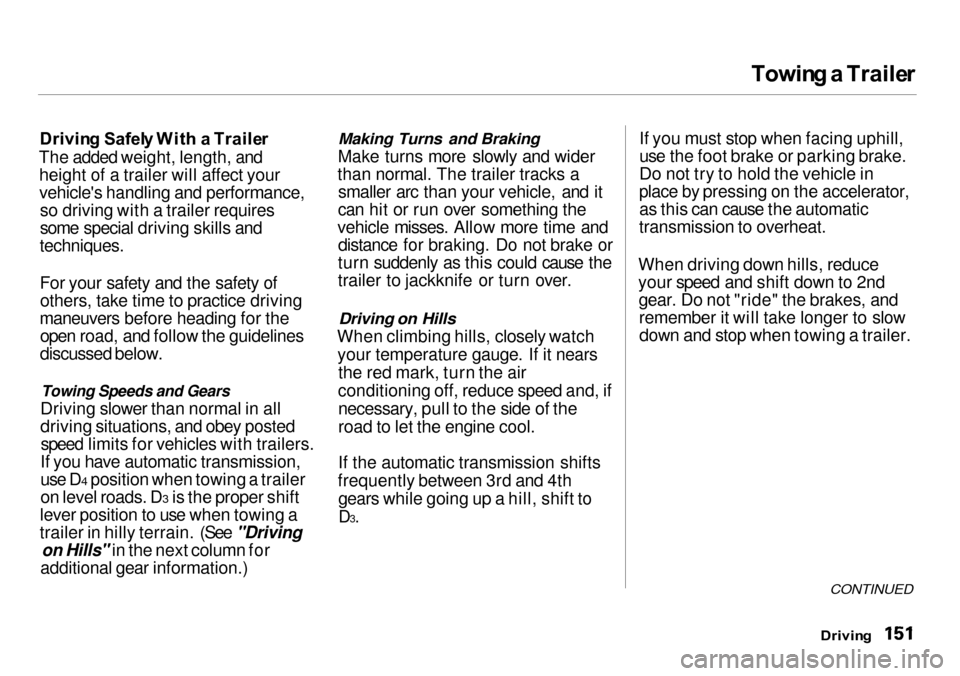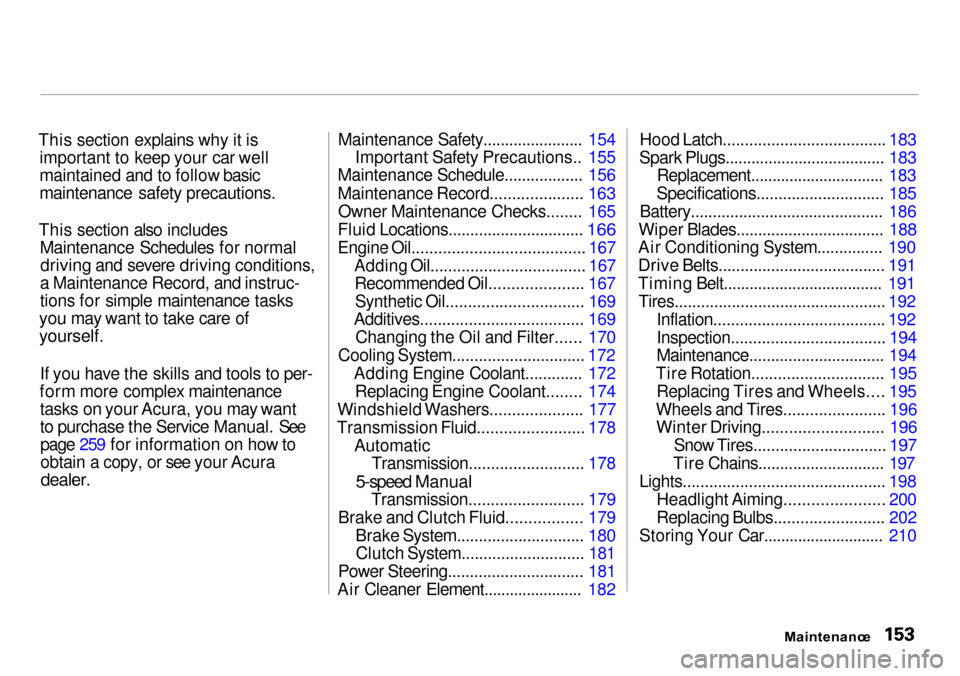Acura Integra 2000 Sedan Owner's Manual
Manufacturer: ACURA, Model Year: 2000, Model line: Integra, Model: Acura Integra 2000Pages: 273, PDF Size: 4.4 MB
Page 151 of 273

Towin
g a Traile r
Checking Load s
The best way to confirm that vehicle and trailer weights are within limits
is to have them checked at a public
scale.
Using a suitable scale or a special
tongue load gauge, check the tongue
load the first time you set up a towing combination (a fully-loaded
vehicle and trailer), then recheck the
tongue load whenever the conditions
change.
Towin
g Equipmen t an d
Accessorie s
Towing can require a variety of equipment, depending on the size of
your trailer, how it will be used, and
how much load you are towing.
Discuss your needs with your trailer
sales or rental agency, and follow the
guidelines in the rest of this section.
Also make sure that all equipment is properly installed and that it meets
federal, state, province, and local
regulations.
Hitches
Any hitch used on your vehicle must be properly bolted to the underbody.
Drivin g
Exceeding load limits or
improperly loading your vehicle
and trailer can cause a crash in
which you can be seriously
injured or killed.
Check the loading of your
vehicle and trailer carefully before starting to drive.
Page 152 of 273

Towin
g a Traile r
Safety Chain
Always use a safety chain. Make
sure that it is secured to both the trailer and hitch, and that it crosses
under the tongue so it can catch the
trailer if it becomes unhitched. Leave enough slack to allow the
trailer to turn corners easily, but do not let the chain drag on the ground.
Trailer Brakes
Acura recommends that any trailer having a total weight of 1,000 lbs (450 kg) or more be equipped with
its own electric or surge-type brakes.
If you choose electric brakes, be sure they are electronically actuated.
Do not attempt to tap into your
vehicle's hydraulic system. No matter how successful it may seem,
any attempt to attach trailer brakes
to your vehicle's hydraulic system
will lower braking effectiveness and
create a potential hazard.
Trailer Lights
Your vehicle has a trailer lighting connector located behind the leftside panel in the cargo area. Refer to
the drawing above for the wiring
color code and purpose of each pin.
If you use a converter, you can get
the connector and pins that mate
with the connector in your vehicle
from your Acura dealer. Since lighting and wiring vary with
trailer type and brand, you should also have a qualified technician
install a suitable connector between
the vehicle and the trailer.
CONTINUED
Drivin g
GROUN
D
(BLACK )
BACK-U
P LIGH T
(GREEN/BLACK )LEF
T TUR N SIGNA L
(GREEN/BLUE )
RIGH T TUR N SIGNA L
(GREEN/YELLOW )BRAK
E LIGH T
(GREEN/WHITE )TAILLIGH
T
(RED/BLACK )
Page 153 of 273

Towin
g a Traile r
Additional Trailer equipment
Many states and Canadian provinces
require special outside mirrors when
towing a trailer. Even if they don't,
you should install special mirrors if you cannot clearly see behind you, orif the trailer creates a blind spot.
Ask your trailer sales or rental
agency if any other items are recommended or required for your
towing situation. Pre-To
w Checklis t
When preparing to tow, and before driving away, be sure to check the
following:
The vehicle has been properlyserviced, and the tires, brakes,
suspension, and cooling system
are in good operating condition. All weights and loads are within
limits (see page 147).
The hitch, safety chain, and any other attachments are sucure. All items on and in the trailer are
properly secured and cannot shift
while you drive. The lights and brakes on your
vehicle and the trailer are working
properly. Your vehicle tires and spare are
properly inflated (see page 192 ),and the trailer tires and spare are
inflated as recommended by the trailer maker.
Drivin g
Page 154 of 273

Towin
g a Traile r
Drivin g Safel y Wit h a Traile r
The added weight, length, and height of a trailer will affect your
vehicle's handling and performance, so driving with a trailer requires
some special driving skills and
techniques.
For your safety and the safety of others, take time to practice driving
maneuvers before heading for the open road, and follow the guidelines
discussed below.
Towing Speeds and Gears
Driving slower than normal in all
driving situations, and obey posted speed limits for vehicles with trailers.
If you have automatic transmission,
use D4 position when towing a trailer
on level roads. D3 is the proper shift
lever position to use when towing a
trailer in hilly terrain. (See "Driving on Hills" in the next column for
additional gear information.)
Making Turns and Braking
Make turns more slowly and wider
than normal. The trailer tracks a smaller arc than your vehicle, and it
can hit or run over something the
vehicle misses. Allow more time and distance for braking. Do not brake or
turn suddenly as this could cause the
trailer to jackknife or turn over.
Driving on Hills
When climbing hills, closely watch your temperature gauge. If it nears the red mark, turn the air
conditioning off, reduce speed and, if necessary, pull to the side of the
road to let the engine cool.
If the automatic transmission shifts
frequently between 3rd and 4th gears while going up a hill, shift to
D3.
If you must stop when facing uphill,
use the foot brake or parking brake.
Do not try to hold the vehicle in
place by pressing on the accelerator, as this can cause the automatic
transmission to overheat.
When driving down hills, reduce
your speed and shift down to 2nd gear. Do not "ride" the brakes, andremember it will take longer to slowdown and stop when towing a trailer.
Driving
CONTINUED
Page 155 of 273

Towin
g a Traile r
Handling Crosswinds and Buffeting
Crosswinds and air turbulence
caused by passing trucks can disrupt
your steering and cause trailer
swaying. When being passed by a
large vehicle, keep a constant speed
and steer straight ahead. Do not try
to make quick steering or braking
corrections.
Backing Up
Always drive slowly and have someone guide you when backing up.
Grip the bottom of the steering
wheel; then turn the wheel to the left to get the trailer to move to the left,and turn the wheel right to move the
trailer to the right.
Parking
Follow all normal precautions when
parking, including firmly setting the
parking brake and putting the
transmission in Park (automatic) or
in 1 st or Reverse (manual). Also,
place wheel chocks at each of the
trailer's tires.
Drivin g
Page 156 of 273

This section explains why it is important to keep your car well
maintained and to follow basic
maintenance safety precautions.
This section also includes Maintenance Schedules for normaldriving and severe driving conditions,
a Maintenance Record, and instruc-
tions for simple maintenance tasks
you may want to take care of
yourself.
If you have the skills and tools to per-
form more complex maintenance tasks on your Acura, you may want
to purchase the Service Manual. Seepage 259 for information on how to
obtain a copy, or see your Acura
dealer.
Maintenance Safety....................... 154
Important Safety Precautions.. 155
Maintenance Schedule.................. 156
Maintenance Record..................... 163
Owner Maintenance Checks........ 165
Fluid Locations............................... 166
Engine Oil......................................
. 167
Adding Oil................................... 167
Recommended Oil..................... 167
Synthetic Oil............................... 169
Additives..................................... 169
Changing the Oil and Filter...... 170
Cooling System.............................. 172 Adding Engine Coolant............. 172Replacing Engine Coolant........ 174
Windshield Washers..................... 177
Transmission Fluid........................ 178 AutomaticTransmission.......................... 178
5-speed Manual
Transmission.......................... 179
Brake and Clutch Fluid................. 179 Brake System............................. 180Clutch System............................
181
Power Steering..............................
. 181
Air Cleaner Element....................... 182 Hood Latch..................................... 183
Spark Plugs..................................... 183 Replacement............................... 183
Specifications............................. 185
Battery............................................ 186
Wiper Blades.................................. 188
Air Conditioning System............... 190
Drive Belts...................................... 191
Timing Belt..................................... 191
Tires................................................ 192 Inflation....................................... 192
Inspection...................................
194
Maintenance............................... 194
Tire Rotation.............................. 195 Replacing Tires and Wheels.... 195
Wheels and Tires....................... 196 Winter Driving........................... 196
Snow Tires.............................. 197
Tire Chains............................. 197
Lights.............................................. 198
Headlight Aiming.....................
. 200
Replacing Bulbs......................... 202
Storing Your Car............................ 210
Maintenance
Page 157 of 273

Maintenanc
e Safet y
Regularly maintaining your car is the
best way to protect your investment.
Proper maintenance is essential to
your safety and the safety of your passengers. It will also reward you
with more economical, trouble-free driving and help reduce air pollution. This section includes instructions for
simple maintenance tasks, such as
checking and adding oil. Any service items not detailed in this section
should be performed by an Acura
technician or other qualified
mechanic.
Some of the most important safety
precautions are given here. However,
we cannot warn you of every conceivable hazard that can arise in
performing maintenance. Only you
can decide whether or not you should perform a given task.
Maintenanc e
Improperly maintaining this car
or failing to correct a problem
before driving can cause a
crash in which you can be seriously hurt or killed.
Always follow the inspection
and maintenance
recommendations and
schedules in this owner's
manual.
Failure to properly follow
maintenance instructions and
precautions can cause you to
be seriously hurt or killed.
Always follow the procedures
and precautions in this owner's
manual.
Page 158 of 273

Maintenanc
e Safet y
Importan t Safet y Precaution s
Before you begin any maintenance,
make sure your car is parked on
level ground and that the parking
brake is set. Also, be sure the engine
is off. This will help to eliminate several potential hazards: Carbo
n monoxid e poisonin g
fro m engin e exhaust . Be sure
there is adequate ventilation
whenever you operate the engine. Burn
s fro m ho t parts . Let the
engine and exhaust system cool
before touching any parts. Injur
y fro m movin g parts . Do
not run the engine unless in- structed to do so. Read the instructions before you
begin, and make sure you have the tools and skills required.
To reduce the possibility of fire or explosion, be careful when working
around gasoline or batteries. Use a
commercially available degreaser or
parts cleaner, not gasoline, to clean parts. Keep cigarettes, sparks, and
flames away from the battery and all
fuel-related parts.
You should wear eye protection and protective clothing when workingnear the battery or when usingcompressed air.
Maintenance
Page 159 of 273

Maintenanc
e Schedul e
The Maintenance Schedule specifies how often you should have your car serviced and what things need
attention. It is essential that you have
your car serviced as scheduled to retain its high level of safety,dependability, and emissions control
performance.
The services and time or distance
intervals shown in the maintenanceschedule assume you will use your
vehicle as normal transportation for passengers and their possessions.
You should also follow these
recommendations:
Avoid exceeding your car's load
limit. This puts excess stress on
the engine, brakes, and many
other parts of your car. The load
limit is shown on the label on the
driver's doorjamb.
Operate your car on reasonable
roads within the legal speed limit.
Drive your car regularly over a
distance of several miles
(kilometers).
Always use unleaded gasoline with
the proper octane rating (see page
118). Whic
h Schedul e t o Follow :
Service your car according to the
time and mileage periods on one of
the Maintenance Schedules on the
following pages. Select the schedule
for "Severe Conditions" if most of
your driving is done under one or more of the conditions listed on thatpage. Otherwise, follow the schedule
for "Normal Conditions."
Maintenanc e
Page 160 of 273

Maintenanc
e Schedul e
Your authorized Acura dealer knows your car best and can providecompetent, efficient service.
However, service at a dealer is not
mandatory to keep your warranties in effect. Maintenance may be done
by any qualified service facility or
person who is skilled in this type of automotive service. Keep all the
receipts as proof of completion, and
have the person who does the work
fill out the Maintenance Record. Check your warranty booklet for
more information. We recommend the use of Genuine
Honda parts and fluids whenever you
have maintenance done. These are
manufactured to the same high- quality standards as the original
components, so you can be confident
of their performance and durability.
Maintenance , replacemen t o r
repai r o f emission s contro l
device s an d system s may be don e
b y an y automotiv e repai r
establishmen t o r individua l usin g
part s tha t ar e "certified " t o EP A
standards . According to state and federal
regulations, failure to perform
maintenance on the items marked
with # will not void your emissions warranties. However, Acura
recommends that all maintenanceservices be performed at the
recommended time or mileage
period to ensure long-term reliability.
Maintenance